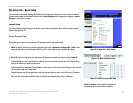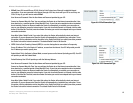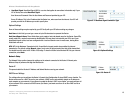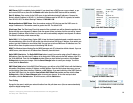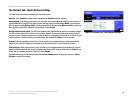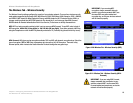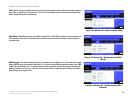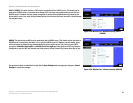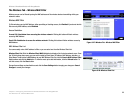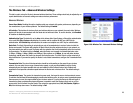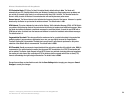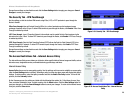
19
Chapter 6: Configuring the Wireless-G Broadband Router with RangeBooster
The Wireless Tab - Wireless Security
Wireless-G Broadband Router with RangeBooster
The Wireless Tab - Wireless Security
The Wireless Security settings configure the security of your wireless network. There are four wireless security
mode options supported by the Router: WEP, WPA Personal, PSK2, PSK2-Mixed, WPA-Enterprise, PSK2 + RADIUS,
and RADIUS. (WEP stands for Wired Equivalent Privacy, and WPA stands for Wi-Fi Protected Access. WPA is a
stronger security method than WEP. PSK2 stands for Pre-shared Key 2, and is stronger than WPA-Personal.
RADIUS stands for Remote Authentication Dial-In User Service.) These seven are briefly discussed here.
WEP. WEP is a basic encryption method, which is not as secure as WPA Personal. To use WEP, select a level of
WEP encryption, 40/64 bits (10 hex digits) or 104/128 bits (26 hex digits). Then either generate a WEP key
using the Passphrase or enter the WEP key manually and select a TX (Transmit) Key (choose which Key to use).
WPA-Personal. WPA gives you two encryption methods, TKIP and AES, with dynamic encryption keys. Select the
type of encryption, TKIP or AES. Enter a passphrase (pre-shared key) of 8-63 characters. Then enter a Key
Renewal period, which instructs the Router how often it should change the encryption keys.
Figure 5-20: Wireless Tab - Wireless Security (WEP)
Figure 5-21: Wireless Tab - Wireless Security (WPA-
Personal)
IMPORTANT: If you are using WPA Personal,
always remember that each device in your
wireless network MUST use the same WPA
Personal method and passphrase, or else the
network will not function properly.
IMPORTANT: If you are using WEP
encryption, always remember that each
device in your wireless network MUST use
the same WEP encryption method and
encryption key, or else your wireless network
will not function properly.



